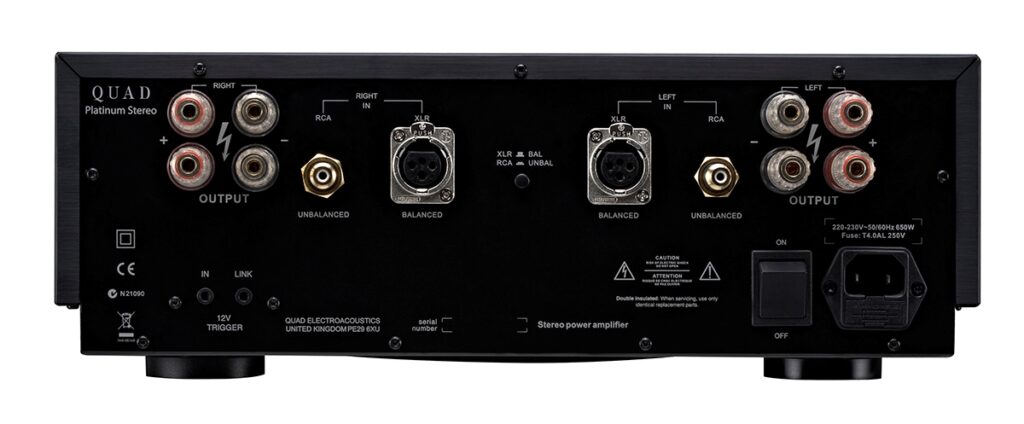The QUAD Platinum Stereo amplifier is the latest in a very long line of hi fi products from QUAD of England. QUAD, which is an acronym for Quality Unit Amplifier Domestic, has been making components since 1953 and has received many awards for the sound quality of their products, including the world-renowned Quad ESL loudspeakers and Quad II vacuum tube power amplifier. Peter Walker developed the first QUAD products and led the company to international success and acclaim.
The Platinum series, which includes a digital music player, a preamplifier, and stereo and mono amplifiers, is their top tier product line followed by the Elite and Vena series. The Platinum Stereo amplifier is rated at 180 Watts per channel, has both RCA and XLR connections, and a trigger connection for remote turn on and turn off. The amplifier’s gain is relatively high at 32.5 dB, suggesting good compatibility with passive preamplifiers. The Platinum Stereo amplifier has a list price of $3,250, depending on the exchange rate with our friends across the pond.

The review system includes a VPI Aries 3 turntable with a Kuzma 4-Point tonearm, ZYX UNIverse Premium, Miyajima Madake, Clearaudio Titanium V2, Lyra Atlas moving coil cartridges; Pass Labs XP-25 phono preamplifier; custom Windows 7 music computer running JRiver Media Center 22; Cary DAC-200ts and Mytek Brooklyn DACs, the latter with external power supply; Lynx Hilo AD/DA converter with external power supply; Mark Levinson No. 52 and Acoustic Imagery Jay-Sho preamplifiers; Rogue Audio Stereo 100, Cary CAD-805AE, Hot Rod Inspire Fire-Bottle SE, Bryston 2.5B3, Pass Labs XA30.8, and McIntosh MC152 power amplifiers; and Emerald Physics 4.7, Fritzspeakers Carrera BE, augmented with a pair of JL Audio e110 subwoofers, and Focal Chorus 714 loudspeakers borrowed from the HT system. The cabling is Audioquest WEL Signature and Mogami interconnects and speaker cables. USB cables include Wyred4Sound USB PCOCC Premium and Lavricables “dual head” cable. Power protection and purification are provided by a PS Audio Dectet for the preamplifiers and source components, and a PS Audio Quintet for the power amplifiers. The latter provides remote turn-on and -off of power amplifiers that lack a 12V remote trigger.
There have been many other power conditioner-type products that have passed through the system over the years, some quite expensive. These PS Audio products take care of the distortion-causing components of my local electric grid. They do the job 24/7. Power cables are DIY Power Cords.
The Platinum Stereo amplifier has a sonic signature that is markedly unlike the other amplifiers mentioned above. While the upper frequencies are completely free of any sense of solid state hardness and glare, this is accompanied by a reduction in the leading edge impact and crispness of natural sounds. The leading edge impact of impulsive sounds, such as drum hits, seems muted which reduces the feeling of power, drive, and involvement. This can provide a sense of intimacy with small ensemble and solo performances, but larger scale music, especially genres which require great dynamic impact, is not the Platinum’s forte.

Specific instrument locations on a very wide and somewhat deep soundstage blend with other instruments resulting in an often indistinct aural image of the musicians. This is rarely noted with small groups, but a full orchestra can present a wall of sound without individual instruments. However, in an orchestra, it is still possible to locate the string section, brass section, etc. Picking out a soloist is a challenge.
The overall character of the Platinum amplifier is similar to the Inspire Fire-Bottle vacuum tube amplifier with 6V6 output tubes installed. As noted in the Inspire review, the 6V6 tubes deliver a nice warm midrange, but with noticeably limited treble response. The QUAD amp has very good bass. The Class A Pass XA30.8 amplifier has a very linear and extended treble range that will sound bright and forward in a system that is voiced for the more laid back character of the QUAD amp. These amplifiers are not interchangeable without significant system alterations to maintain a proper tonal balance across the audio frequencies, from low bass to uppermost treble.
This review is focused mainly on the negative aspects of the amplifier’s performance for two reasons. First, these comments dominate my listening notes. And second, making you aware of the negatives is much more valuable to you than telling you how good it sounds in certain parameters. After all, you purchase a component because of how good it can sound, but you replace it – sooner or later – due to its failings.
The QUAD Platinum stereo is a good sounding amplifier which captures the essential musical value of recordings. Its character could be a good fit in a carefully matched system that compensates for and enhances the unique sonic perspective.
Overall Rating: 7 LPs
Link to QUAD
